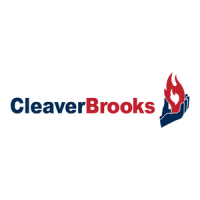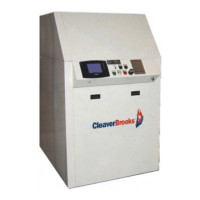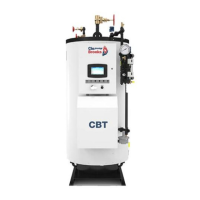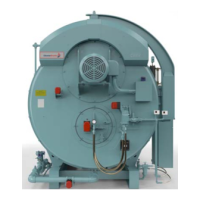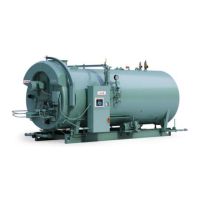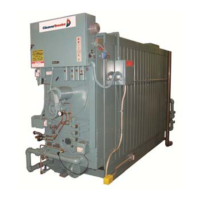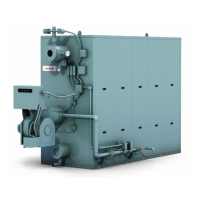CFC-E Installation Manual
Part No. 750-459 2-13
2.8 - Combustion Air/Boiler Room Ventilation Requirements
The boiler(s) must be supplied with adequate quantities of uncontaminated air to support proper
combustion and equipment ventilation. Air shall be free of chlorides, halogens, fluorocarbons,
construction dust or other contaminants that are detrimental to the burner/boiler. If these contaminants
are present, we recommend the use of direct vent combustion provided the outside air source is
uncontaminated.
Combustion air can be supplied by means of conventional venting, where combustion air is drawn from
the area immediately surrounding the boiler (boiler room must be positive pressure), or with direct vent
(direct vent combustion) where air is drawn directly from the outside. All installations must comply with
local Codes and with NFPA 54 (the National Fuel Gas Code - NFGC) for the U.S. and for Canada, CAN/
CGA B 149.1 and B 149.2.
For models CFC-E 2500-6000: If using direct venting in a multiple boiler application, an individual air
duct is required for each boiler.
For models CFC-E 500-2000, consult your local Cleaver-Brooks representative for combined
combustion air ductwork consideration.
Note: A boiler room exhaust fan is not recommended as this type of device can cause a negative pressure in the boiler room if
using a conventional air intake.
In accordance with NFPA54, the required volume of indoor air shall be determined in accordance with
the “Standard Method” or “Known Air Infiltration Rate Method”. Where the air infiltration rate is known to
be less than 0.40 Air Changes per Hour, the Known Air Infiltration Rate Method shall be used (see
Section 8.3 in the NFPA54 Handbook for additional information).
2.8.1 - Air Supply - Unconfined Spaces (For U.S. Installations Only)
A. All Air From Inside the Building - If all combustion air is drawn from inside the building (the
mechanical equipment room does not receive air from outside via louvers or vent openings and
the boiler is not equipped with direct vent combustion) and the boiler is located in an unconfined
space, use the following guidelines:
1. The mechanical equipment room must be provided with two permanent openings linked directly with additional
room (s) of sufficient volume so that the combined volume of all spaces meet the criteria for an unconfined space.
Note: An "unconfined space" is defined as a space whose volume is more than 50 cubic feet per 1,000 Btu per hour
of aggregate input rating of all appliances installed in that space.
2. Each opening must have a minimum free area of one square inch per 1,000 Btu per hour of the total input rating
of all gas utilizing equipment in the mechanical room.
3. One opening must terminate within twelve inches of the top, and one opening must terminate within twelve inches
of the bottom of the room.
4. Refer to the NFGC, Section 8.3 for additional information.
B. All Air From Outdoors - If all combustion air will be received from outside the building (the
mechanical room equipment is linked with the outdoors), the following methods can be used:
1. Two Opening Method - The mechanical equipment room must be provided with two permanent openings, one
terminating within twelve inches from the top, and one opening terminating within twelve inches of the bottom of
the room.
2. The openings must be linked directly (Figure 2-7) or by ducts (Figure 2-8) with the outdoors.
3. Each opening must have a minimum free area of one square inch per 4,000 Btu per hour of total input rating of all
equipment in the room, when the opening is directly linked to the outdoors or through vertical ducts.
4. The minimum free area required for horizontal ducts is one square inch per 2,000 Btu per hour of total input rating
of all the equipment in the room.
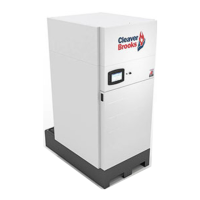
